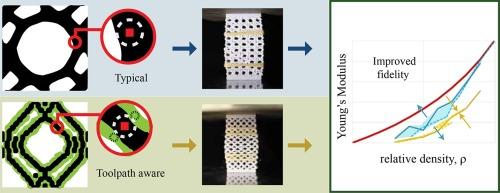3d打印材料结构的拓扑优化:设计中的测试工具路径考虑
IF 7.9
2区 材料科学
Q1 MATERIALS SCIENCE, MULTIDISCIPLINARY
引用次数: 0
摘要
与常用的几何参数控制设计方法相比,应用于材料结构设计的拓扑优化(TO)方法允许对可能的设计空间进行更广泛的探索。这些优化设计通常采用直接墨水书写方法来实现,这种方法具有离散晶珠尺寸和弱晶珠键合的特点。如果在设计中没有考虑到设计保真度的缺乏和刀具轨迹相关的各向异性,则会对结构性能产生负面影响。本文通过扩展喷嘴约束拓扑优化算法和针对典型基线的实验验证结果,解决了细胞材料结构设计过程中的两个特征。详细介绍了一种导出键区材料性能的实验方法。提出了一种由拓扑优化结果直接生成刀具轨迹的方法。与传统的拓扑优化设计方法进行了比较,并对其性能进行了实验和数值测试。在相对密度≤70%时,具有喷嘴约束的设计能够在性能和设计保真度(由相对密度测量)方面更接近数值和实验结果。相比之下,传统的拓扑优化设计具有更高的整体性能,但设计意图与实验结果之间的一致性很小。典型的设计总是过度沉积材料和不一致的预测性能。本文章由计算机程序翻译,如有差异,请以英文原文为准。

Topology optimization of 3D-printed material architectures: Testing toolpath consideration in design
Topology Optimization (TO) methods applied to the design of material architectures allow for a wider exploration of the possible design space when compared to common geometry parameter controlled design methods. These optimal designs are often realized using Direct Ink Writing methods which exhibit characteristic features of discrete bead sizes and weak bead bonding. The resultant lack of design fidelity and toolpath dependent anisotropy has been found to negatively impact structural performance if not accounted for in the design. This paper addresses both characteristics in the design process of cellular material architectures by expanding upon the Nozzle Constrained Topology Optimization algorithm and experimentally validating the results against a typical baseline. An experimental method of deriving bond region material properties is detailed. A direct toolpath generation method from topology optimized results is proposed. Comparisons are made with conventional topology optimization design methods and performance is measured both experimentally and numerically against theoretical bounds. At relative densities , designs with nozzle constraints were able to more closely align numerical and experimental results for both performance and design fidelity (measured by relative density). In contrast, conventional topology optimized designs had higher overall performance, but little alignment between intended design and resultant experimental result. Typical designs consistently overdeposited material and inconsistently predicted performance.
求助全文
通过发布文献求助,成功后即可免费获取论文全文。
去求助
来源期刊

Materials & Design
Engineering-Mechanical Engineering
CiteScore
14.30
自引率
7.10%
发文量
1028
审稿时长
85 days
期刊介绍:
Materials and Design is a multi-disciplinary journal that publishes original research reports, review articles, and express communications. The journal focuses on studying the structure and properties of inorganic and organic materials, advancements in synthesis, processing, characterization, and testing, the design of materials and engineering systems, and their applications in technology. It aims to bring together various aspects of materials science, engineering, physics, and chemistry.
The journal explores themes ranging from materials to design and aims to reveal the connections between natural and artificial materials, as well as experiment and modeling. Manuscripts submitted to Materials and Design should contain elements of discovery and surprise, as they often contribute new insights into the architecture and function of matter.
 求助内容:
求助内容: 应助结果提醒方式:
应助结果提醒方式:


